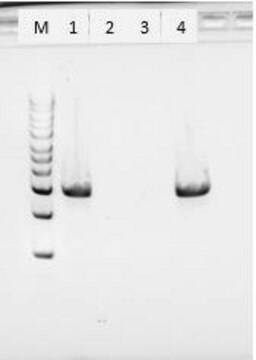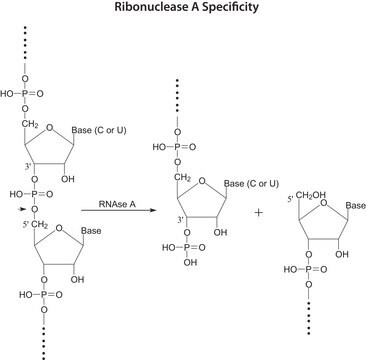P8044
Proteinasa K from Tritirachium album
≥3.0 unit/mg solid, lyophilized powder
Sinónimos:
Endopeptidasa K
About This Item
Productos recomendados
biological source
maize
microbial (T.album
T. ALBUM)
plant seeds (barley)
soybean
yeast
Quality Level
form
lyophilized powder
specific activity
≥3.0 unit/mg solid
mol wt
28.93 kDa
composition
Protein, ≥15% biuret
technique(s)
DNA extraction: suitable
application(s)
diagnostic assay manufacturing
storage temp.
−20°C
¿Está buscando productos similares? Visita Guía de comparación de productos
Categorías relacionadas
Application
Elimina las endotoxinas que se unen a las proteínas catiónicas como la lisozima y la ribonucleasa A.
Se ha comunicado que es útil para el aislamiento de mitocondrias hepáticas, de levadura y de frijol mung
Determinación de la localización de las enzimas en las membranas
Tratamiento de cortes de tejido incluidos en parafina para exponer los sitios de unión de antígenos para el marcado con anticuerpos.
Digestión de proteínas de muestras de tejido cerebral para investigación de los priones en las encefalopatías espongiformes transmisibles (EET).
Biochem/physiol Actions
Unit Definition
signalword
Danger
hcodes
Hazard Classifications
Eye Irrit. 2 - Resp. Sens. 1 - Skin Irrit. 2 - STOT SE 3
target_organs
Respiratory system
Storage Class
11 - Combustible Solids
wgk_germany
WGK 1
flash_point_f
Not applicable
flash_point_c
Not applicable
ppe
dust mask type N95 (US), Eyeshields, Faceshields, Gloves
Elija entre una de las versiones más recientes:
Certificados de análisis (COA)
¿No ve la versión correcta?
Si necesita una versión concreta, puede buscar un certificado específico por el número de lote.
¿Ya tiene este producto?
Encuentre la documentación para los productos que ha comprado recientemente en la Biblioteca de documentos.
Los clientes también vieron
Artículos
Proteinase K (EC 3.4.21.64) activity can be measured spectrophotometrically using hemoglobin as the substrate. Proteinase K hydrolyzes hemoglobin denatured with urea, and liberates Folin-postive amino acids and peptides. One unit will hydrolyze hemoglobin to produce color equivalent to 1.0 μmol of tyrosine per minute at pH 7.5 at 37 °C (color by Folin & Ciocalteu's Phenol Reagent).
Protocolos
Proteinase K (EC 3.4.21.64) activity can be measured spectrophotometrically using hemoglobin as the substrate. Proteinase K hydrolyzes hemoglobin denatured with urea, and liberates Folin-postive amino acids and peptides. One unit will hydrolyze hemoglobin to produce color equivalent to 1.0 μmol of tyrosine per minute at pH 7.5 at 37 °C (color by Folin & Ciocalteu's Phenol Reagent).
Nuestro equipo de científicos tiene experiencia en todas las áreas de investigación: Ciencias de la vida, Ciencia de los materiales, Síntesis química, Cromatografía, Analítica y muchas otras.
Póngase en contacto con el Servicio técnico





